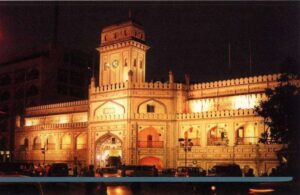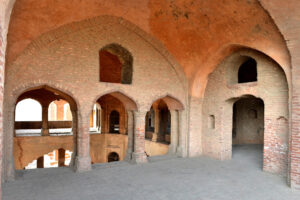
One of the important elements for the growth of commerce and economic life in Mughal India was sarais. Sarais were established institutions and were designated resting places for travellers. They were variously called sattras, chavadis, caravanserais, dharamshalas etc. and were an important feature at that time, providing shelter to the travellers enroute. The travellers mainly consisted of merchants, pilgrims, traders and state-officials and their troopers in Medieval India. Usually, it was established to provide accommodation for overnight stay for the travellers.
The earliest evidence pertaining to establishment of sarais run by the state and its staff are from Waqiat-i-Mushtaqi which may have been compiled before 1581 and tells us that Sher Shah Sur is said to have initiated this building of sarais on a large scale. According to this source, at every sarai a mosque, a royal chamber and well is said to have been established and to every mosque a muazzin and an imam, and shiqdar were appointed and their land grants were located in the same place. Damdama, currently known as Reserve Police Lines and located 2 kilometres from the Mathura cantonment railway station on the Agra route, is the oldest surviving sarai structure that was either pre-mughal or possibly a Sur construction.It was only during the reign of Mughals that this work of building sarais was carried out extensively.
There was very little uniformity in the Mughal Sarais’ construction of the structure and materials, including the number of accommodations available.They could be built with either stones, muds, bricks or even of thatched huts. Some were in square-like cloisters while some of them were built like palaces. William Finch noted that the Chhaparghata Sarai was able to accommodate a thousand men which was apparently built during Akbar’s reign. Bernier had a bad impression of sarais in India but he admired and was impressed by a sarai which was built by Princess Jahan Ara, the eldest daughter of Shah Jahan in Delhi and wished to be built the same in various parts of Paris. The enclosed area of sarais were usually divided into halls, dwelling rooms and the chamber for the attendants, verandas, with trees inside the courtyard and also had places for the animals brought in by the travellers. The better sort had one or two wells, hammams, a mosque, shops for provisions etc. as suggested by N.A. Anjum.

We get to know about sarais from numerous sources primarily from the travellers account, persian chronicles and inscriptions. It is evident from these sources that there were various male and female staffs to maintain the sarais and serve the travellers such as darbans (gatekeeper), aablash (water-carrier), khakrob (sweeper), etc. We have the mention of bhatiyaras and bhatiyarins – who are believed to be particular groups of Muslims to serve the travellers and are occasionally used interchangeably with mehtar and mehtaranis. The work of cooking and cleaning the rooms etc. may have been performed by the female members of bhatiyaras families settled in the sarais. It may be possible that the mehtar and mehtaranis were the cleaners and sweepers of the sarais. No rent was charged from the ulema (the learnt), suleha (the pious), fuqera (the dervishes) and zayer harmain sharif (visitors from Mecca and Medina).
The services at the sarais apart from lodging were space for their animals and belongings, free food in some sarais and security. Akbar ordered the kitchens to be established in the sarais on high roads, however, the travellers had to arrange their own bedding. In Mughal India, sarais were built on the emperor’s, princes’, princesses’, imperial officials’, for administrative and economic purposes and occasionally even philanthropists’ commands. Akbar’s reign is when the endowments for sarais constructed by private individuals are mentioned at the earliest.
Nur Jahan, queen of Jahangir, also built some important sarais such as the Nurmahal ki sarai at Sikandra on the opposite side of Agra, the Badshahi Sarai at NurMahal in Jalandhar. Shah Jahan and Aurangzeb also took considerable interest in building sarais. A sarai of Jahangir’s reign is located at Aram Bagh in Agra and is locally known as Raja ki Sarai. During the Mughal Period, the royal highway from Agra to Lahore was also dotted with caravanserais and most of these structures have now fallen prey to vandalism and ruins. The Mughal sarai at Shambhu (district Patiala, East Punjab) is one of the fortunate survivors of these sarais structures and stands at an excellent state of preservation thus, providing us with ample amount of information about the structure of sarais.
The larger sarais that were constructed and established by the state had a complex organisational structure. Each sarai had an overarching incharge who oversaw the sarais and was in charge of keeping them in order. He also oversaw the grants associated with the sarais. This official had a sizable support of subordinate staff working for them. By all accounts, there were good security measures in place in the relatively larger state-owned sarais to protect travellers from thefts and illegal seizures and was a necessary tool to boost economy, social and cultural life in medieval India.

